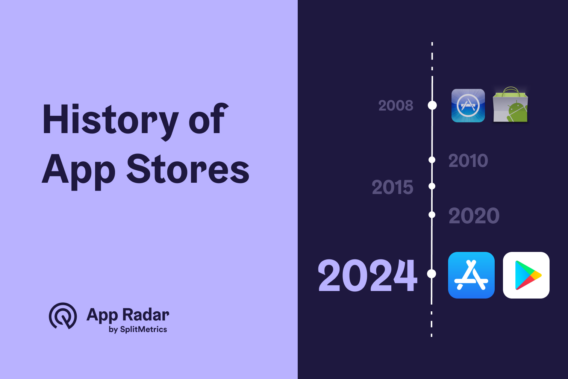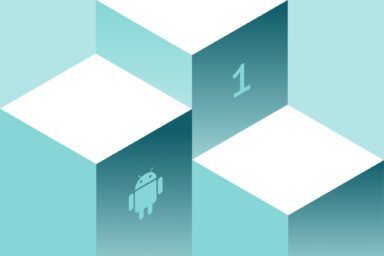App Store History: The Evolution of the App Marketplace From 2008 to 2024
The app marketplace has undergone a remarkable transformation since its inception in 2008. From the humble beginnings of the Apple App Store and Google Play Store, the landscape has evolved into a dynamic ecosystem that drives innovation and economic growth. This article covers key milestones and developments that have shaped the app marketplace over the years.

The Birth of the App Stores (2008)
2008
- March: Apple App Store Announcement: Apple announces the upcoming release of the App Store.
- July: Google Play Store Launch – The Android Market (now Google Play Store) is opened.
- August: Google announces the release of the Android Market.
- October: Apple App Store Launch, the App Store officially opens with 500 applications available.
Early Growth and Expansion (2009-2012)
2009
- March: Google Play Store has 2,300 apps available.
- April: Apple App Store reaches 1 billion downloads with 35,000 apps available.
- July: Apple App Store hits 1.5 billion downloads with 65,000 apps available.
- September: Apple App Store reaches 2 billion downloads with 85,000 apps available.
2010
- January: Apple App Store hits 3 billion downloads.
- July: Google Play Store reaches 100,000 apps available.
2011
- January: Apple App Store reaches 10 billion downloads.
- February: Introduction of the Android Market Webstore.
- April: Google Play Store hits 3 billion downloads.
2012
- March: Android Market becomes Google Play.
- June: Apple App Store reaches 30 billion downloads and $5 billion paid out to developers.
- June: Google Play Store hits 20 billion downloads with 600,000 apps available.
The Rise of In-App Purchases and Subscriptions (2013-2016)
2013
- April: Apple App Store reaches 45 billion downloads and $9 billion paid out to developers.
- September: Google Play Store hits 102 billion downloads with $26 billion in sales.
2014
- June: Apple App Store reaches 75 billion downloads with 1.2 million apps available.
2015
- March: Google Play introduces staff-reviewed app submissions and age-based ratings.
- May: Google Play introduces A/B test experiments.
2016
- June: Apple App Store reaches 130 billion downloads with $50 billion paid to developers.
- October: Apple Search Ads goes live.
The Era of App Store Optimization (2017-2020)
As the app marketplace matured over time, App Store Optimization (ASO) became a key practice for enhancing app visibility and driving downloads.
The introduction of ASO tools and techniques allowed developers to better understand user behavior, track performance metrics.
Developers and marketers started implementing data-driven strategies that increase app engagement and retention.
New approaches like keyword optimization, A/B testing, and leveraging user feedback became necessary parts of the app development lifecycle.
2017
- March: Developers can respond to App Store reviews.
- September: Introduction of iOS 11, which included a complete redesign of the App Store.
- December: Apple publishes new rules for the App Store.
2018
- June: At WWDC 2018, Apple announces that developers have earned over $100 billion from the App Store.
- December: Apple tightens requirements for app publication, particularly for VPN applications and user data protection.
2019
- March: Google introduces new policies to improve app quality and security.
- September: Apple Arcade is launched, offering a subscription service for exclusive games.
2020
- March: Google Play Pass is expanded to more countries.
- June: Apple announces the App Store Small Business Program.
- December: Google introduces new policies to enhance app transparency.
The Impact of COVID-19 on the App Marketplace (2020-2021)
2020
- Surge in Downloads: Increase in app downloads and usage during the pandemic, particularly in categories like remote work tools and health apps.
2021
- Apple introduced In-App Events, which are timely events within apps and games, such as game competitions, movie premieres, and live-streamed experiences.
- Apple introduces App Tracking Transparency (ATT) with iOS 14.5.
- Apple launched Custom Product Pages and Product Page Optimization, allowing developers to create different product pages for specific audiences and test various elements to improve conversion rates
- Apple introduced new App Analytics features in App Store Connect, providing with data on re-downloads, total downloads, proceeds, average revenue per paying user (ARPPU)
- Google announced new policies to improve app quality.
- Google enforced new policies policy aimed to improve the quality and relevance of app listings. App titles got limited to 30 characters and the use of popular keywords such as “best,” “free,” “top,” and “new.” got prohibited
- Google introduced custom store listings, enabling developers to create tailored content for different user segments
- Google made enhancements to deep linking tools to help developers optimize user engagement and app discovery
Recent Trends and Innovations (2022-2024)
2022
- Apple introduces new privacy labels.
- Apple blocked 1.7 million applications from being published on the App Store due to privacy, security, and content standards violations.
- The App Store celebrated its 15th anniversary
- Over the years, the App Store has grown to feature more than 1.8 million apps and has paid out over $320 billion to developers from 2008 to 2022
- Google launches the Data Safety section.
- Google introduced up to 50 Custom Store Listings, allowing developers to create personalized app pages for different audience segments.
- Google expanded the LiveOps feature that is called Promotional content today, enabling developers to submit content for featuring on the Play Store
2023
- March: Apple announces new guidelines for app submissions.
- July: Google introduces new policies to enhance app security.
- December: Apple introduced a new fee structure, reducing the App Store commission from 30% to 17% for developers, and eliminated commissions for developers who use alternative payment methods or third-party app stores.
- Google introduced AI-powered features to the Play Store, enhancing app discovery and user engagement.
- Google improved custom store listings, allowing developers to create tailored content for different user segments.
2024
- February: Approximately 37,000 apps were released in the App Store in February alone.
- March: Apple allowed third-party app stores on iPhones and iPads for the first time.
- April: Apple introduced over 50 new reports in App Store Connect, providing detailed insights into app performance, user engagement, and commerce.
- April: Current market statistics show that 1,609 apps are launched daily in the Google Play Store.
- May: Google Play Games on PC expanded to more than 140 markets, with a catalog of over 3,000 titles.
- May: Google Play Store introduced custom store listings with keyword optimization targeting feature.
It is worth mentioning that app stores have become huge marketplaces with changes happening almost on a weekly basis. Nevertheless, we wanted to provide an overview of big events in the history of app stores that matter for ASO and to overall app marketing community.
If you want to understand different app store optimization rules for each app store, we highly recommend checking our guide to Android app optimization in Google Play, as well as our guide to iOS app optimization in App Store.

Latest Posts

iOS App Product Page Localization: How to Use it the Right Way to Improve ASO
Top 10 Most Downloaded Games in Google Play Store (July 2025 Update)
Google Play Store Listing Experiments: How to Run Native A/B testing for Android Apps for Free!
12 Best Mobile Measurement Partners (MMPs) to Consider for Your Mobile App Attribution in 2025
Related Posts

